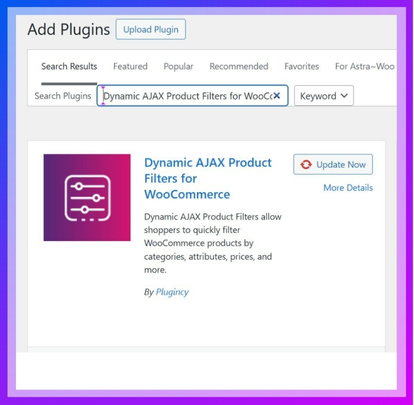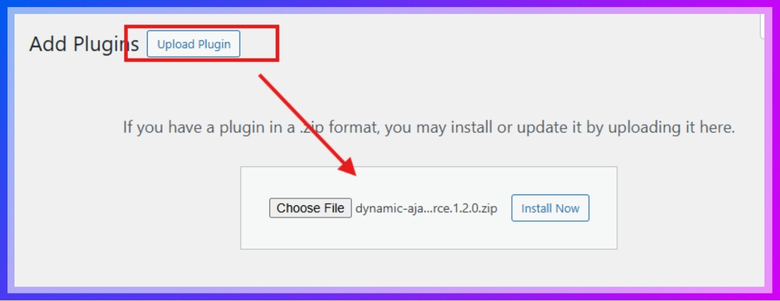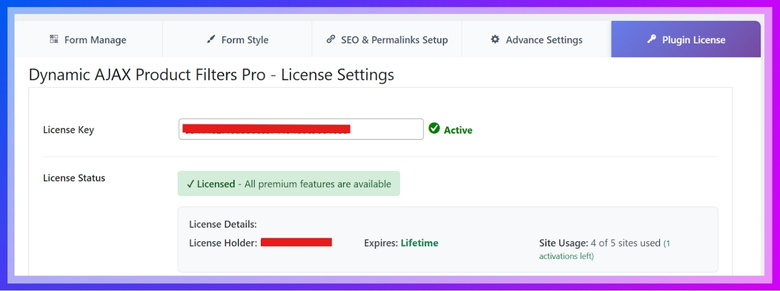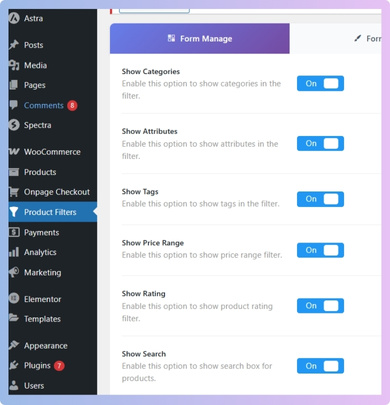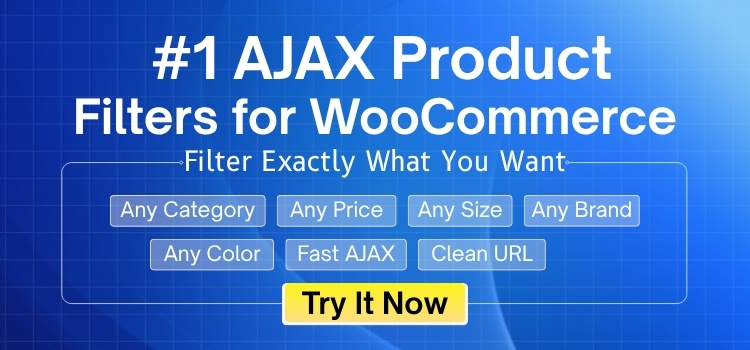WooCommerce powers many online stores and helps people sell products in a simple way. Shoppers expect to find items quickly without spending too much time. That is why store owners often wonder how to combine search and filters in WooCommerce.
Combine search and filters in WooCommerce by using the Dynamic AJAX Product Filters plugin. Install the plugin, enable both search and filter options in the settings, and display them together on your shop page. Customers can then search and refine results instantly, improving product discovery without reloading pages.
Do you want to know how search and filters affect speed, SEO, and customer shopping experience? If you are curious, keep reading this article because you will find all the key details explained step by step with clear examples and solutions.
How to Combine Search and Filters in WooCommerce?
You can combine search and filters without a plugin by writing custom code in your theme and using WooCommerce’s native widgets. This method is powerful but needs solid PHP and JavaScript skills. If you want a faster setup with no coding, use a plugin.

Step 1: Install the Plugin
It is a filtering system built for WooCommerce stores that uses AJAX to update product results instantly on the same page. Called Dynamic Ajax Product Filters, it allows shoppers to refine what they see by applying conditions such as category, attribute, tag, price, or rating. Instead of reloading the page every time a filter is applied, the results change smoothly in real time, creating a quick and uninterrupted browsing flow. This makes it a powerful WooCommerce Ajax product filter plugin for any online store.
Installation (Free Version)
- Go to Plugins in your WordPress dashboard.
- Click Add New Plugin.
- In the search bar, type Dynamic AJAX Product Filters for WooCommerce.
- Click Install Now.
- Click Activate.

Installation (PRO Version)
- Go to Plugins.
- Click Add New Plugin.
- Click Upload Plugin.
- Click Choose File and select the plugin ZIP.
- Click Install Now, then Activate.

- Go to Product Filters > Plugin License; in the License key box, paste the license code you get after purchasing the paid version.

Step 2: Open the Filter Settings
Once the plugin is active, you need to configure it to show the right options. This step is important because it connects the search with filters so they work together.
- In your WordPress admin, go to Product Filters > Form Manage.
- You will see toggles for different filter options.
Step 3: Enable Filters and Search
The next step is to choose what options will appear for customers. Turning these on makes the search box and filters show together.
- Toggle on the following options:
- Show Categories
- Show Attributes
- Show Tags
- Show Price Range
- Show Rating
- Show Search
- Click Save Changes.

Step 4: Test on the Shop Page
After saving, check your shop page to confirm everything works. This makes sure both search and filters are active at the same time.
- Go to your Shop page in the front end.
- Use the search box to look up a product name.
- Apply one or more filters (like price or rating).
- Confirm the product list updates correctly with both search and filters applied.
With these steps, you can combine search and filters easily in WooCommerce. Just install, activate, and set up the options, and your store will have a better product browsing experience.
How Do Search and Filters Affect WooCommerce Store Performance?
When running an online store, search and filter features play a big role in how customers explore products. They make shopping easier, but they also affect how fast your store loads and how search engines see it. Let’s look at the details.
Store Speed
Search and filters can slow down your store if not handled properly. Every time a customer uses them, the system must fetch data from the database. If the database is large or queries are not optimized, speed drops. Slow speed can frustrate shoppers and reduce sales.
Page Load Time
Filters often generate new results in real-time. This means the store has to reload or fetch updated product lists. If too many filters run at once, page load time increases. A fast store keeps users engaged, while delays may drive them away.
Search Indexing
Search engines index product pages to show them in results. When filters create many duplicate or dynamic URLs, it may confuse search engines. If indexing is not managed well, search engines may skip key pages, lowering visibility in search results.
Server Load
Filters and search put extra pressure on your hosting server. When many visitors use these tools together, servers handle multiple queries at the same time. If resources are limited, performance issues appear. A strong hosting setup helps balance the load.
Optimization Steps
Using caching, limiting unnecessary filters, and choosing lightweight search plugins can improve performance. Clean URLs and SEO-friendly filter settings also help with indexing. Optimized tools give customers a smooth shopping experience while keeping store performance healthy and reliable.
Search and filters improve user experience, but they need proper setup to avoid slowing down your WooCommerce store. With the right optimization, you can enjoy speed, better indexing, and happy customers.
SEO Impact of Combining Search and Filters in WooCommerce
When running an online store, search and filter options play a big role in how products are found. They also connect directly with search engines, which means they can impact how your store pages appear online. Read these useful tips below.
- Clean URLs: Always make sure filter URLs are short and simple because long, messy URLs confuse both users and search engines.
- Canonical Tags: Add canonical tags to filtered pages so search engines know which version to prioritize and avoid duplicate content issues.
- Index Control: Use meta robots settings carefully to prevent unimportant filtered combinations from being indexed while allowing valuable ones to rank.
- Static Pages: Create static categories or landing pages for popular filtered searches so they have stable, clean URLs with SEO benefits.
- Breadcrumbs: Adding breadcrumbs to filtered pages helps both search engines and users understand the path and structure of your website content.
- Unique Content: Give important filtered result pages some unique content or descriptions to help them stand out and improve SEO value.
- Avoid Parameters: Replace unnecessary query parameters in filter URLs with clean paths to ensure they are easier to crawl and index correctly.
- XML Sitemap: Include key filtered pages in your XML sitemap so search engines can discover and index them without relying on random crawling.
- Consistent Structure: Keep the URL structure consistent across your site so filters don’t create confusing variations that weaken your SEO performance.
- Performance Speed: Optimize filtered pages to load quickly because slow pages reduce user engagement and may affect search engine ranking over time.
Filters and search can strengthen SEO when handled wisely. Clean URLs, clear structure, and smart indexing make your WooCommerce store easier for search engines to read, while also giving customers a smooth browsing experience.
How Can You Test the Effectiveness of Search and Filters in WooCommerce?
Search and filter tools play a big part in online shopping. They guide customers to products without making them scroll endlessly. But how well do these tools really work in your store? Testing can help you find clear answers and improvements. Here are some practical ways to test how well search and filters work in WooCommerce.
A/B Testing
With A/B testing, two different versions are compared to see results. Customers interact with both, and the data shows which performs better. This method helps decide the best layout, placement, or style choices. It makes sure your store works smarter, not harder.
Heatmap Tools
By using heatmaps, you can see where users click or stop. This helps you understand if filters or search boxes are visible. If they are being ignored, changes can be made quickly. Heatmaps provide clear insight into how users behave on-site.
Performance Checks
Running performance checks makes sure search and filters are loading quickly. Testing often highlights broken layouts or slow load times, and fixing WooCommerce filter issues at this stage helps ensure a smoother shopping experience. This ensures your tools run fast and reliably.
Analytics Reports
Looking at analytics shows how search and filters affect shopping time. You can check how long it takes for results to appear. It also reveals which filters are used most or least often. This data guides you toward smart and effective improvements.
User Feedback
Listening to customer opinions gives a deeper view of their struggles. Feedback highlights whether search and filter tools are actually useful. It also reveals hidden problems that reports and tools may miss. Honest responses from real users lead to practical improvements.
Testing search and filter tools is important for smooth online shopping. Every check helps find errors and makes store performance much better. Customers stay longer when filters are quick and easy to use. Strong testing means more sales and happier shoppers.
What Are the Limitations of Using Only Search or Only Filters?
Building an online store means giving customers the right tools to find products quickly. Both search and filters are useful, but each has limits when used alone. To understand this better, let’s look at some key points below.
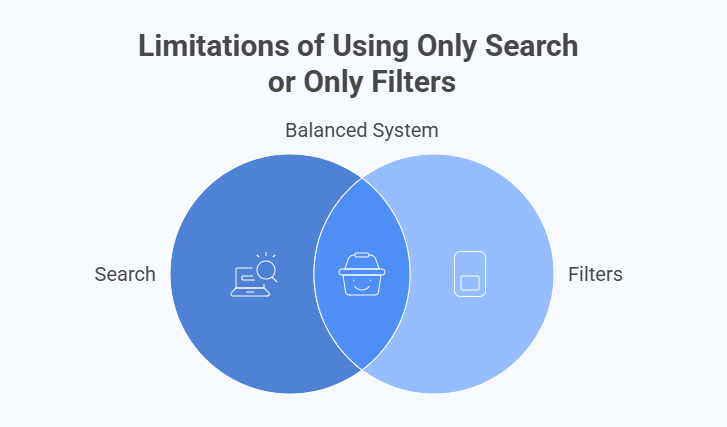
Too Broad
Search tools can sometimes show too many results at once. Customers may feel overwhelmed and struggle to find what they want quickly. Without proper guidance, they might even leave the store. This shows why search alone is not always effective.
Too Narrow
Filters can cut down options too much and hide products that customers might like. If filters are very strict, some items never appear. Shoppers may think the store has fewer products than it does. This creates a poor browsing and shopping experience.
User Confusion
Relying on just search or just filters can confuse users. If customers are not guided clearly, they may spend extra time browsing. Confusion can lead to frustration, and frustration often means abandoned carts and fewer completed purchases.
Missing Balance
When only one option is used, the balance between choice and guidance is lost. Search alone can return too many results, which is why filters such as the WooCommerce price filter are essential to narrow down options within a customer’s budget.
Limited Discovery
Filters may block out new or related products, while search might not highlight hidden gems. Customers might miss out on discovering items that suit them. Combining both tools gives the right mix of accuracy and product discovery.
Search and filters work best when used together, not alone. Each one has weaknesses that the other can fix. Customers find shopping easier when both tools support each other. A balanced system leads to more satisfied shoppers and sales.
FAQs About How to Combine Search and Filters in WooCommerce?
Adding both search and filters in WooCommerce can improve product discovery and give customers a smoother shopping experience. Many store owners have questions about setup, usability, and best practices. Below are some of the most important questions and answers.
Can I Customize Filter Styles?
Yes, most plugins allow you to customize how filters look on your store. You can change layouts, choose dropdowns or checkboxes, and match colors with your theme. This makes your filters look natural within your shop design. Custom styling helps customers feel more comfortable using them.
Do Filters Work With Mobile?
Good plugins are designed to be mobile-friendly and responsive. This means filters and search will adjust to smaller screens without problems. Customers should still find it easy to use both tools on phones. Always test on different devices to be sure.
Can I Show Filters By Default?
Yes, you can set filters to appear automatically when customers open the shop page. This saves them extra clicks and time. When filters are visible upfront, people understand the available options quickly. It improves browsing without making things complicated.
How Do Filters Affect Checkout?
Filters do not directly affect the checkout process, but they influence how quickly a product is found. Faster discovery usually means customers add items to their cart sooner. With fewer distractions, they move smoothly to checkout. This helps increase completed sales.
Can Filters Be Category-specific?
Yes, filters can be different for each category of products. For example, clothing might show size and color filters, while electronics show brand and features. This makes filters more useful for customers. It avoids irrelevant options that could confuse them.
Do Filters Work With Variations?
Most filter plugins support product variations like size, color, or material. This helps customers find exactly what they need more easily. Variations appear as separate filter options, making the shopping process faster. Always ensure your plugin is updated for full support.
Can I Add Custom Attributes?
Yes, custom product attributes can be added as filter options. For example, if you sell handmade goods, you can create filters for material type. These custom filters make your shop unique. Customers get more accurate results based on their preferences.
Do Filters Slow Down My Store?
Filters can sometimes slow down a store if not optimized well. Using a lightweight plugin reduces the load. Caching and good hosting also help keep things fast. Always test performance after adding filters and search to check speed.
Are Filters Good for Large Stores?
Filters are especially useful in large stores with many products. They help narrow down thousands of items into smaller, manageable groups. Without them, customers would spend too much time searching. Good filters make shopping easier and improve satisfaction.
Can Filters Work With Tags?
Yes, many filter plugins allow filtering by product tags. This makes it easy to group items by themes or special categories. For example, tags like “new arrival” or “eco-friendly” can be filters. It adds another layer of convenience for shoppers.
Conclusion
Search and filters are both powerful tools for any online store, but when used alone, they can create limits for shoppers. A balanced setup makes the store more user-friendly, gives better product discovery, and keeps customers happy while exploring products.
The clear answer to how to combine search and filters in WooCommerce is by using the Dynamic AJAX Product Filters plugin. It allows you to enable categories, tags, price, rating, and search together without coding, so customers enjoy a smooth and faster shopping process.
To get the best results, always test your store speed, keep filter URLs clean, and remove unnecessary options. A smart setup saves time for your shoppers and improves SEO. Keep these tips in mind, and best wishes for your WooCommerce store.
